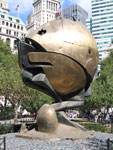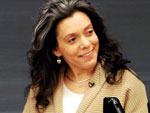Elizabeth Schaefer on the Impact of 9/11 in the Classroom

Early in the year, teachers scramble to put back on their 500 hats and begin the year on the right foot. For the past two years, I have used a September 11th interview project in my 8th-grade U.S. History class to meet many early-in-the-year needs. With a week of instruction and one project, I have been able to better understand the level and lives of the students, communicate with families early on, set the tone for thinking historically within my class, and most importantly, gotten the students engaged and excited about American history.
The original idea began simply with concern that my 13- and 14-year-old students did not understand what actually happened on 9/11 or its relation to our presence in Afghanistan and Iraq. Simultaneously, I knew I needed to meet standards and could not linger too long on a timeframe outside of my content area. Based on this balance of social studies duties, I ended up using 9/11 as a lens to teach the beginning of the year’s "history tools and vocabulary" unit. The consequential project design ended up looking like this during the first full week of school (ideal for a pre-Labor Day start time):
Monday - Students are introduced to primary and secondary sources and basic vocabulary. They work in groups to perform a primary source analysis on four different pieces: New York Times Sept. 12 cover, a photograph of people crying, a photograph protesting the backlash against Muslims, and the transcripts from 911 conversations. I found the conversations through my local NPR website. The students record descriptions, inferences, and questions.
Tuesday - The students take guided notes on what happened during the day of September 11th, a simplistic statement about "why,” and basic bullet-pointed effects. I include the people that died from a variety of countries and positions in life, the economy, changes in transportation, the related wars, and increased hate crimes against Muslims.
Wednesday - The interview project itself is introduced. Students brainstorm a possible person to interview about their September 11th experience. In class, the students create two sourcing questions (find out about your subject), four experience questions (find out about his or her experience) and two opinion questions (find out about his or her thoughts or life after). Questions are modeled to demonstrate open-ended and information-based questions.
Thursday - The students bring in a minimum of 10 questions which they should have developed for homework (including the eight from the day before) and the class conducts peer edits based on open-endedness and knowledge.
Friday - Check back in with all students to make sure they have an interview plan. Model how to ask an adult to interview and set them up to turn the project in successfully with a grading rubric. The grading rubric involves an outline including an introduction to the interview, a question/answer section, and finally a four-part conclusion including a connection they made with their subject, a surprise, an additional question, and finally a reflection on the experience.
Due Date - In my classes, the interview project has been due on or next to the anniversary of 9/11. The students take a mini-quiz on the topic and then the students each share-out about their interview. This has been a very special day both years that I have done this project.
As this was my second year using this project, several major adjustments were made. First, I fully committed to the mini-unit and had no qualms about using a full week to make sure that it integrated practical history skills and provided time for clarity. My students have been very interested in this subject and have many questions. When you are approaching this, there needs to be an outlet and plenty of time for an excess of GOOD questions.
Secondly, this year I mentally prepared to get political and stick to the historic facts. The knowledge students have on this subject largely comes from their families. They have surprised me with their in-depth knowledge of conspiracy theories as well as confusion about their parents' anti-Islamic statements. I recommend requesting a trusted person to observe you if this is a concern. I personally felt relieved after my mentor teacher viewed a session to ensure that I was teaching the students to be good, knowledgeable citizens of the world as well as inquisitive historians without veering off the facts.
Finally, I had come to accept that as a middle-school teacher I should be in the beginning of their education, not the end. Although the students and I both want to go deeper into the history and the causes of September 11th, I needed to give myself clear boundaries recognizing the pieces I could teach effectively in the time allowed.
Next year more changes will be needed. I plan to increase guidance on how to interview. In retrospect, a full model interview session would have been helpful. Although the student's questions improved year-to-year, I would also like to move my next group closer to thinking deeply about the unique perspective of their subject and formulating questions based on their location, job, or past. As of now, this is the only interview that my students conduct, but I am considering making it a gateway to a more advanced interview later in the year to make sure that the students are growing in inquiry skills instead of just information.
Early in the year, the results of this one-week experience are powerful for the teacher. The excitement about history is tangible in the classroom and written in student reflections. The information gathered about families on the second week of school is invaluable in a way that a parent survey could never be. With a very structured project outline, the data gathered on student's writing, ability to reapply knowledge, and ability to follow directions is worth much more than the test averages from the year before.
As for the students, according to their quizzes, they no longer think that the Pentagon is in New York or that Iraq is directly responsible for 9/11. Their conclusions however tell of a much deeper impact:
"I can't believe something so big happened during my lifetime and I never really knew about it."
"I did not know that my mom knew stuff about history. I really liked talking to her about this. "
"My dad told me more about 9/11 than the questions but I didn't report it because it was too personal. He cried and that never happens."
Interested in teaching 9/11 yourself? Try the September 11 Digital Archive or September 11, 2001: Attack on America for primary sources.
Created for the Bracero Archive, "People as Primary Sources: Conducting Interviews" presents useful tips for conducting oral history interviews.


